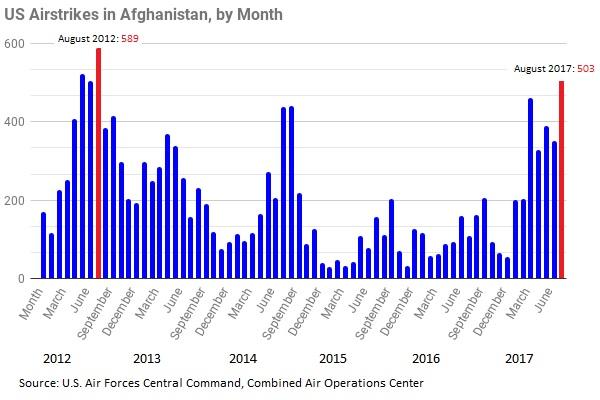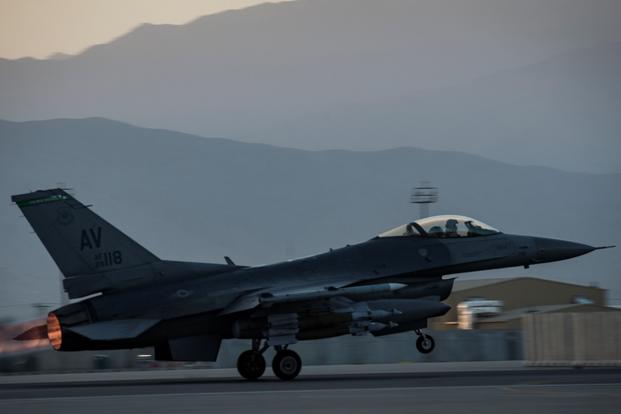The U.S. Air Force in August released more than 500 weapons in Afghanistan against terrorist organizations such as the Taliban, al-Qaida and the Islamic State, marking the most in a single month since 2012, according to newly released figures.
Aircraft such as F-16 Fighting Falcon fighter jet and MQ-9 Reaper drone have dropped more than 2,000 bombs this year, already almost doubling the number of weapons released during all of last year, according to Air Forces Central Command's latest airpower summary.
The busy strike month came as President Donald Trump, Defense Secretary Jim Mattis and top brass at the Pentagon met to discuss a new strategy for Afghanistan going forward.
"We're in the process of doing the detailed planning [for] that strategy," Air Force Chief of Staff Gen. David Goldfein told Military.com on Saturday while traveling to the annual conference of the National Guard Association of the United States in Louisville, Ky.
Related content:
- F-15Es, A-10s Leading Air War Against ISIS
- Trump Signals More Troops to Afghanistan, But Doesn't Cite Number
- After US Drops 'Frankenbomb' on Afghanistan, Questions Linger
"And the discussion that we're having is -- which is led by the supported combatant commander but supported also by the joint chiefs -- and that is, 'What's the air-ground team that's required to be able to now execute the strategy that the president has laid out?'" Goldfein said.
Trump on Aug. 22 announced the U.S. will send more troops to Afghanistan to step up the fight against the Taliban and the offshoot of the Islamic State of Iraq and Syria called Islamic State-Khorasan province, or IS-K.
The president would not cite specific numbers, but defense officials have said 3,500 to 5,000 additional troops are likely as part of the plan, which has been endorsed by Mattis.
'We've Never Come Back'
Goldfein said he doesn't foresee "a significant plus-up" in aircraft "because we've never actually come down; we just repurposed the force against various priorities," referencing the shift from the war against al-Qaida to the air war against ISIS.
"So what I see happening as we look to increase the size of the force on the ground, there will be a corresponding demand, or lift, [for] personnel recovery; command and control; close-air support; [intelligence, surveillance and reconnaissance], all those things that we do," he said.
"I don't think you're going to see it change that much," said Goldfein, who served as the U.S. Air Forces Central Command commander between 2011 and 2013. "Again, because we've never come back. We've been engaged in Afghanistan the entire time."

The chief also said that despite the August uptick, the number of airstrikes in country per month are relatively steady -- in the hundreds -- and that they weren't exponentially increasing by the day. He didn't elaborate on why the rate last month was higher than usual.
Even before the president's highly anticipated announcement of an updated strategy for Afghanistan -- his first major military and foreign policy plan since taking office in January -- Army Gen. John Nicholson, commander of U.S. forces in Afghanistan and the NATO Resolute Support mission, had already been increasing airpower in the region.
In April, Nicholson approved the highly publicized drop of the 21,600-pound GBU-43 Massive Ordnance Air Blast (MOAB) -- nicknamed "mother of all bombs" -- against IS-K in the Achin district of eastern Nangarhar province. It was the first time the MOAB, the highest-yielding, non-nuclear bomb in the U.S. arsenal, had been used in combat.
U.S. warplanes, meanwhile, dropped 460 weapons across Afghanistan that same month, more than the two previous months combined. The increase in strikes came from such workhorse aircraft as the F-16 fighter, MQ-9 drone and B-52 Stratofortress bomber.
Strikes Per Aircraft
Since missions were turned over from Operation Enduring Freedom to the NATO-led Resolute Support in 2015, F-16s have dominated the fight, accounting for more than half of strike sorties -- or a flight that includes a strike -- than all the U.S. Air Force aircraft operating in Afghanistan, AFCENT officials told Military.com.
The Vipers, as they’re known in the F-16 community, have also dropped the most weapons -- more than 2,200 -- in that same timeframe, AFCENT spokesman Capt. Jose Davis said.
"The amount of weapons employed by aircraft can vary due to a number of factors, e.g. types of mission and ordnance type," he said in an email.
.tg {border-collapse:collapse;border-spacing:0;}.tg td{font-family:Arial, sans-serif;font-size:14px;padding:10px 5px;border-style:solid;border-width:1px;overflow:hidden;word-break:normal;}.tg th{font-family:Arial, sans-serif;font-size:14px;font-weight:normal;padding:10px 5px;border-style:solid;border-width:1px;overflow:hidden;word-break:normal;}.tg .tg-yzt1{background-color:#efefef;vertical-align:top}.tg .tg-e3zv{font-weight:bold}.tg .tg-9hbo{font-weight:bold;vertical-align:top}
| Aircraft Type | # of Weapons Released (Since 2015) |
|---|---|
| F-16 fighter jet | 2,223 |
| MQ-9 drone | 1,556 |
| B-52 bomber | 807 |
| B-1B (no longer in theater) bomber | 56 |
| MQ-1 drone | 33 |
Davis cautioned that the numbers released by the command -- which includes assets and actions only under the Combined Forces Air Component Commander, or CFACC -- don't reflect the entirety of kinetic activity in Afghanistan, which may also come from, for example, aircraft operating under Special Operations Joint Task Force Afghanistan, or SOJTF-A.
Trailing behind the F-16 is the "hunter-killer" Reaper, the larger, more lethal General Atomics-made drone, as it takes on more missions as the Air Force slowly phases out its cousin, the MQ-1 Predator.
The B-52 long-range bomber has a lower strike and sortie number. Air Force officials have said that this could be attributed to the fact it has not been in theater as long as its fighter and unmanned aerial vehicle counterparts. The Stratofortress replaced the B-1B Lancer in theater in 2016, but carries 5,000 pounds less in munitions than its supersonic bomber cousin.
Davis also noted the B-1B has a lower strike effect in the statistics, since it left the theater in early 2016 to return to the States for required depot maintenance. The Air Force has said it is "flexible" on the Lancer's return to the air wars over the Middle East.
Changing Rules of Engagement
The Pentagon last June announced then-President Barack Obama had approved an expansion of U.S. airstrikes against terrorist organizations in Afghanistan, giving more authority to commanders in the area of responsibility to call airstrikes in support of ground troops embattled in the 16-year-long conflict.
It signaled a similar approach to what the military began doing in the fight against the Islamic State in Iraq and Syria in April 2016 -- a "rapid execution" of strikes, ordered and authorized by commanders.
The move allowed the U.S. to redefine its role in the air campaign as more than an air support operation.
The announcement came a month after retired Army Gens. David Petraeus, former head of U.S. Central Command, and John Campbell, who commanded the International Security Assistance Force and United States Forces-Afghanistan from August 2014 to March 2016, urged the administration to increase striking authority.
"Simply waging the Afghanistan air-power campaign with the vigor we are employing in Iraq and Syria -- even dropping bombs at a fraction of the pace at which we are conducting attacks in those Arab states -- will very likely make much of the difference between some version of victory and defeat," Petraeus said in a Wall Street Journal commentary at the time.
While the Trump plan for Afghanistan has not been fully articulated, he has made clear his preference to give more leeway to generals to take a more aggressive approach to stamp out the threat, with more troops -- albeit not yet more aircraft -- committed to the fight.
-- Oriana Pawlyk can be reached at oriana.pawlyk@military.com. Follow her on Twitter at @Oriana0214.






























